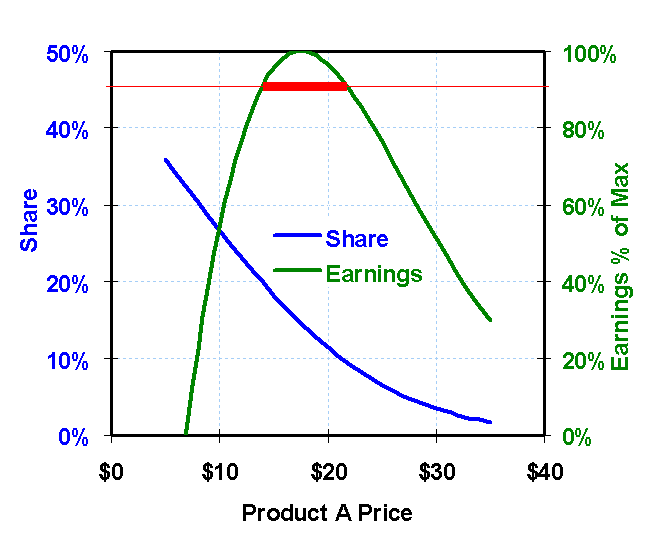The expected goal of pricing policy is to maximize long-term earnings. While this is a simple concept, it is a difficult problem complicated by uncertainties, competitors, multiple products, and segments. The core issue, however, is always the customer demand—how often your products or services will be purchased compared to a set of competing alternatives at various prices. The measured customer demand should be the critical driving factor for any pragmatic approach to setting price.
The Optimum Price
From a practical perspective, the starting point for pricing should be the optimum price—the price that maximizes short-term earnings, assuming that competitors’ prices remain constant. With knowledge of the market price sensitivity and the marginal costs, potential earnings are computed.

As shown in the graph to the left, the blue line is the expected share at a defined price, assuming that the other prices remain constant. The green line represents the earnings as a percent of the maximum earnings over the same price range. The maximum point is the optimum price. Having both the share and earnings allows the business team to estimate the cost in earnings of increasing share.
Determine the Optimum Price
There are four steps to determine the optimum price and successfully implement a price change.
1. Identify the structure of the business.
This involves specifying the competitive set, the relative manufacturing and marketing costs, relevant market segments, and the key value segments. The business will need to define the product life cycle, value structure (brand and performance), and competitive brand positioning.
2. Design, test, and field the appropriate market research.
This should be done by independent marketing research firms. Using the company's sales force or an internal resource for these studies increases the risk of bias that could adversely impact results.
3. Analyze the data and build pricing support tools.
For the pricing process heuristic, tools and models are developed that allow for the identification of optimum pricing. Dynamic value maps are also developed to help define alternative strategic pricing positions. Typically, this analysis goes well beyond pricing issues to include perceptual, importance, and competitive quadrant maps as well as a range of other marketing and quality analyses.
4. Engage the team in workshops to use the tools to set the pricing policy.
It is critical that not only are the policies agreed upon, but also that the organization, and in particular the sales forces, supports it. Too many policies fail due to lack of support. A major purpose of the analytical approach is to build consensus within the organization. That is, the analytical structure provides a rational approach where opinions are tested against market measurements.
Additional Benefits of Pricing Optimization
The models developed can be used to conduct “what if?” analyses. The approach can be expanded upon to estimate pricing policies for multiple products in the same product family. The approach is also consistent with Six Sigma methodologies for Six Sigma practitioners. The team approach ensures alignment and the sharing of information. The pricing approach can be combined with other tools to create a business toolkit that can be upgraded over time.





